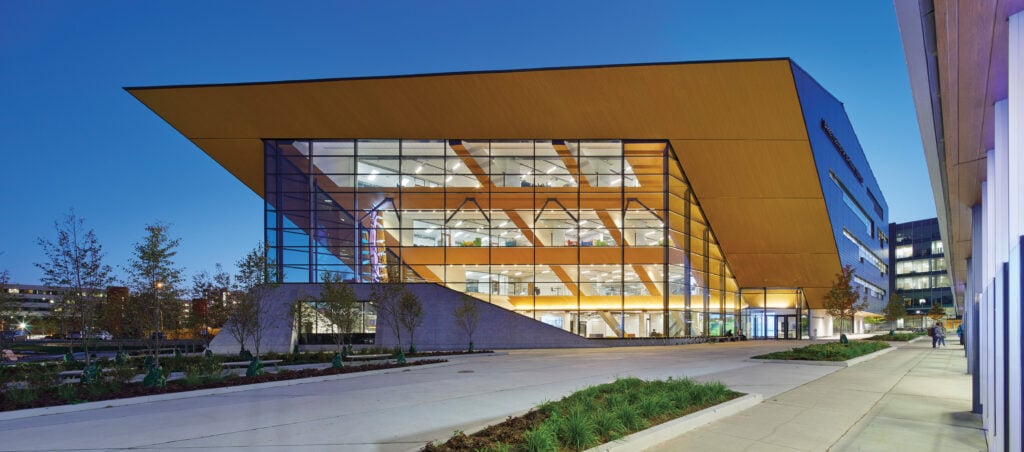
July 12, 2022
What Is Good Interior Design?
Last year, I was invited to join the jury of a large architecture and design firm’s internal awards program, in which teams from around the world submitted recently completed projects. Every applicant was asked to express their project outcomes within the American Institute of Architects’ Framework for Design Excellence, which the organization adopted in October 2019 as “the defining principles of good design in the 21st century.”
In reviewing the entries, I noticed something interesting. The projects that shone were ground-up undertakings—drawing on the full gamut of design services like architecture, interior design, and landscape architecture. The applications that fared the worst at making a case for themselves using the framework? Interior design–focused projects like renovations, tenant improvements, or real estate repositioning.
Top: Designed by Chihuahua-based architects urbánika and completed in 2021, The Regional Center for Autism Care in Ciudad Camargo, Mexico, provides care for autistic children through therapy and education. The building was designed based on cognitive accessibility indicators established by the Superior Center of La Salle Madrid University Studies that include easy exterior identification of the building, clear entry points, color-coding, and strategic wayfinding, to name a few. Read more in “Designing for Autism.” COURTESY LALO TALAMANTES
So how can interior designers better understand and articulate the impact of their work? The five recently created frameworks below, developed by both Metropolis and some of the nation’s key advocacy groups, provide some crucial guidance. And there’s plenty more to look forward to. The IIDA has formed an Equity Council that will soon be announcing new initiatives; the International WELL Building Institute has convened a Health Equity Advisory to develop a rating system; and mindful MATERIALS is building a Common Materials Framework to guide specification. (See our NeoCon publication, Specify, for more on the latter.)
The issue you hold features interior design that acknowledges diversity of sensory needs, access, age, and income. The work of Motionspot (“Access Granted,”) Pal Experiences (“Design for Autism,”) and architects designing housing in Los Angeles (“Taking On L.A.’s Homeless Crisis,”) proves that when we go above and beyond to be inclusive, we open up new fields of possibility for design.
All professionals need a clear understanding of what constitutes excellence in their field, and that standard must encourage working toward the greater good. I look forward to seeing these varied initiatives coalesce into a vision of how interior design can shape a better future for us all.
SETTING A HIGHER BAR FOR INTERIOR DESIGN
If you are an interior designer or work with interior designers, here is a list of pledges, commitments, and initiatives to help you set standards for your practice:
ASID Outcome of Design Toolkit, 2019
ASID’s Outcome of Design Awards were created to encourage designers to focus on research-based results. A by-product of the program is a simple spreadsheet for designers to map out and articulate the outcomes of their work.
AIA Architects & Designers Materials Pledge, 2020
Designers can make a huge impact on climate change, ecosystem health, human health, and social equity through their specifications. Adopted by the AIA in October 2020, this pledge lays out a comprehensive framework for responsible material selection and comes with a starter guide.
Interior Design Pledge for Positive Impact, 2021
At NeoCon 2021, ASID, IIDA, Interior Designers of Canada, and Metropolis came together to launch the first comprehensive framework for interior design to make a positive impact on both people and planet. The pledge comprises three interconnected commitments to design for climate, health, and equity.
Metropolis’s Climate Toolkit for Interior Design, 2021
We have only recently become aware of the cumulative carbon emissions associated with interior design. This toolkit, created through a participatory process involving stakeholders from all parts of the U.S. interior design industry, offers a set of strategies for professionals to help fight climate change.
IIDA Designing What’s Next, 2022
IIDA’s 24th Industry Roundtable, held in early 2022, focused on how interior designers can design for a better future. The report on the roundtable is full of strategies, thought starters, and resources for greater equity, relevance, and resilience.
Would you like to comment on this article? Send your thoughts to: [email protected]
Related
Products
Autodesk’s Forma Gets You Ahead of the Curve on Carbon
Autodesk Forma leverages machine learning for early-phase embodied carbon analysis.
Products
Eight Building Products to Help You Push the Envelope
These solutions for walls, openings, and cladding are each best-in-class in some way—offering environmental benefits, aesthetic choices, and design possibilities like never before.
Viewpoints
3 Sustainability News Updates for Q3 2024
Policy initiatives are gathering momentum as the federal government and building sector organizations align their expertise under the umbrella of the Inflation Reduction Act.

























